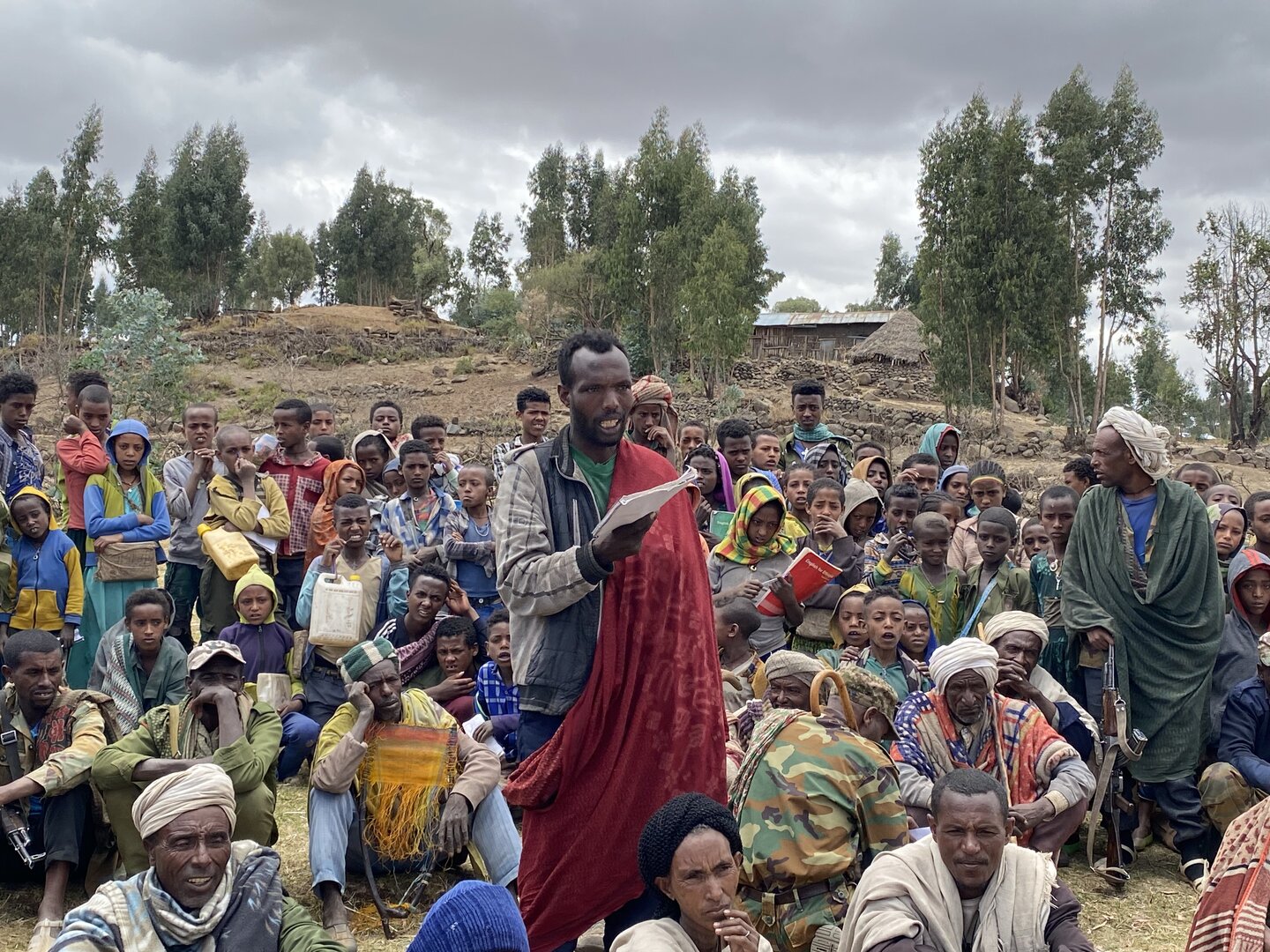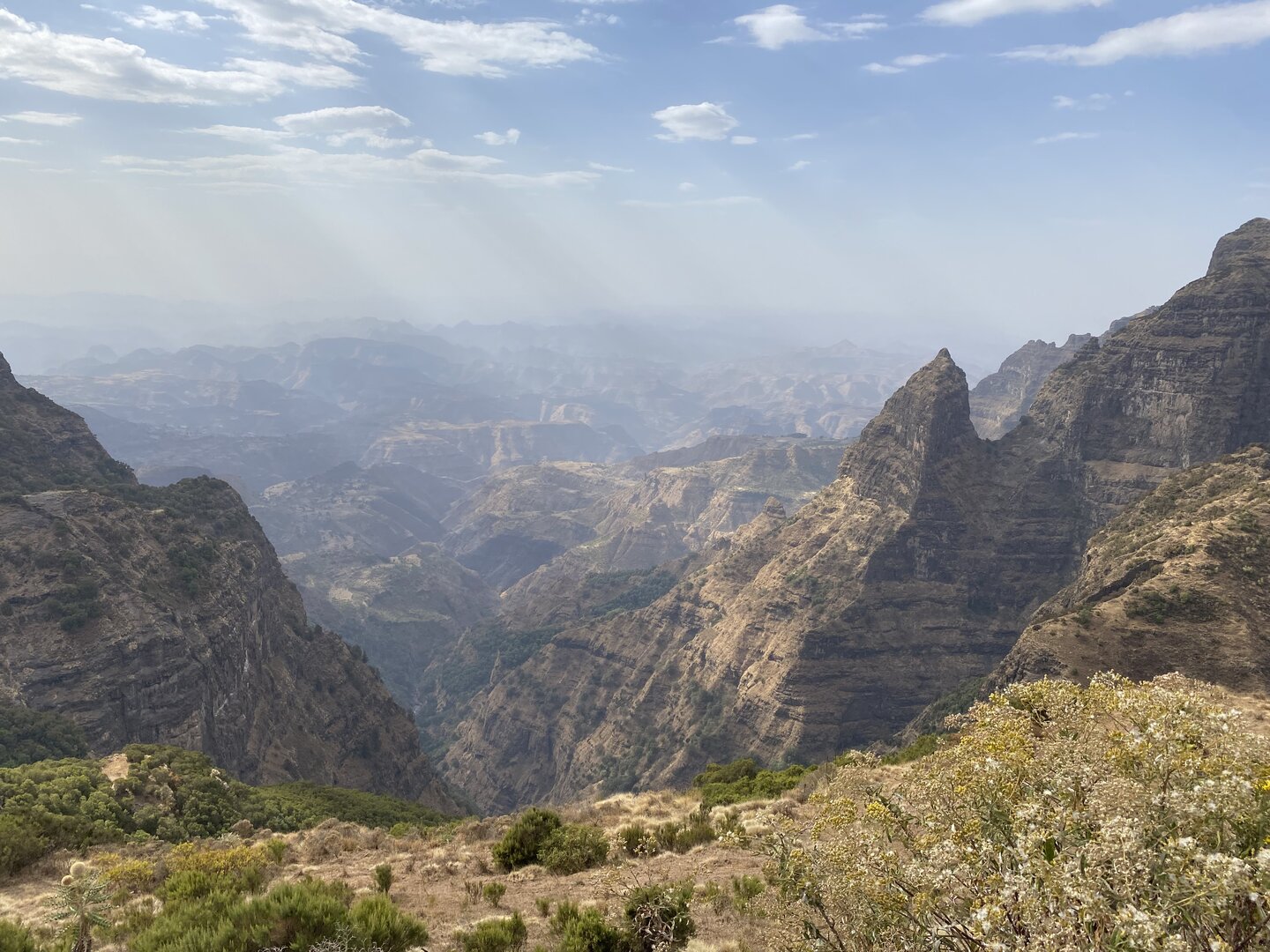Any visitor to Ethiopia’s North Gondar zone will be struck by the sheer numbers of people eking out an existence on the rolling hills that rise to the stunningly beautiful Semien Mountains. Farming is subject to the vagaries of rainfall that is becoming increasingly unreliable due to climate change — sometimes there are heavy storms; at other times, expected rain fails to fall. Temperatures are also becoming warmer. The sloping lands are vulnerable to soil erosion, which is exacerbated by the open grazing of livestock and deforestation, especially for charcoal production, on higher areas. Grey-green Eucalyptus trees line fields and cluster in small plots; with their fast, straight growth they provide excellent construction poles for houses, but are also blamed for drying up the soil. This, however, is a matter of choice — fast growth demands water. It is in this context of high pressure on natural resources that the Semien Gondar Resilience Project (SEGORP) operates.
An integrated landscape approach
Agriculture, livestock, soil and trees are all integrally linked, so it makes sense to address them through a landscape approach. The Ethiopian government has a well-established program that is doing this, taking watersheds as a landscape made up of several micro-watersheds. The program promotes terracing and earthen bunds to capture rainfall and maximize infiltration into the soil. It also introduces new, drought-resilient crop varieties and cultivation methods and encourages the backyard rearing of livestock (with fodder cut and carried to them) as well as the protection of any remaining native forests. Support is also provided for various livelihood activities such as poultry, solar panels and biogas plants.
SEGORP aims to support and enhance the Ethiopian government’s watershed program through a community-led approach in two watersheds: one in Debark Woreda (district) and one in Janamora Woreda. The project is jointly implemented by Helvetas and Concern Worldwide, and is funded by the Austrian Development Agency and by a private foundation. Watershed committees in each of the micro-watersheds, of which there are ten in total, are guided to become legally registered cooperatives, meaning that they have a permanent status. Opportunities to develop income-generating activities — especially, but not only, for women — are supported through Village Saving and Loans Associations. Maternal and child nutrition is addressed through trainings, awareness-raising and the distribution of vegetable seeds, while a change in the generally very unequal relations between women and men at the household level is addressed through Social Analysis and Action Groups. Throughout the project activities, there is an emphasis on reaching the poorest and most vulnerable in the community.
Community-led development
At a community meeting in Gashajagre kebele (village administration) in Janamora Woreda, participants are keen to express the sense of empowerment that the project has brought.
“The watershed plan was developed with the participation of everyone. We organize all the activities ourselves; we are disciplined and meet regularly according to the rules that we ourselves have decided. This is the big difference from the government approach,” said Molla W/Mikael (St Michael), a priest and leader of a micro-watershed committee.
“We ourselves select who should receive specific livelihood support,” adds committee member Mulaw Asimamaw. “We do this without bias, focusing on who has the greatest need. We can justify our selection through a Complaint Response Mechanism that allows those who are not selected to raise their claim. We learned about this and other aspects of our work as committee members through visiting the project in Gojjam and talking with the people there.” Here, he is referring to the Helvetas-implemented Amhara Local Governance Project, which has been working on improving local governance since 2019.
Hiwot Worku confirms, “In the past, rich people benefitted from interventions. But this project truly reaches women and the most disadvantaged.”

Progress despite hampered field operations
Needs assessments and training sessions for government staff and community members alike have been important in this first phase of the project, which began in 2021 but was delayed by the nearby conflict in Tigray. This severely hampered field operations and resulted in some funds being reallocated to support the numerous people displaced by the conflict.
Given that there has effectively only been 10-12 months to pursue project activities, the degree of community cohesion and government staff engagement is remarkable. This is no doubt due in part to working in collaboration with Concern Worldwide, which was already active in Janamora with a nutrition program. Furthermore, there are few other development agencies operating in this remote Woreda, and government funds are very limited — so motivation to participate is high.
A focus on climate resilience and food security
Beyond capacity building, the first phase of the project was foreseen as a time to test different interventions that support sustainable natural resource management and contribute to improving people’s lives. In the second phase, the promising interventions that complement the government program will be identified. For example, collaboration with the Gondor Agriculture Research Center has shown noteworthy success with faba beans — which, being nitrogen fixing, enhance soil fertility — and if incorporated regularly into diets, also enhance household nutrition. They are also relatively resilient to varied rainfall. With these characteristics, they are clearly a promising crop for wider promotion in future.
The wider landscape context
The upper reaches of the watersheds where the project operates are the Semien mountains – a natural World Heritage Site, which are also protected as a national park. These mountains are scenically majestic, but are also rich in biodiversity and home to many rare, in some cases endemic, flora and fauna.
Yet the park is under constant pressure from the people living around it. Agricultural productivity is so low and ways to earn a living so limited that any chance to encroach on the park’s land is tempting. Eventually, it is hoped that SEGORP will contribute to easing this pressure through establishing more sustainable and productive land management practices that are owned by the communities themselves.

About the Project
The Semien Gondar Resilience Project (SEGORP) was launched in March 2021 with a goal of strengthening household and community resilience to climate change in three food-insecure districts in Ethiopia. The project is funded by the Austrian Development Agency and by a private foundation, and is jointly implemented by Helvetas and Concern Worldwide.
Helvetas and Concern Worldwide are members of Alliance2015, a strategic network of seven European non-government organizations engaged in humanitarian and development action.


